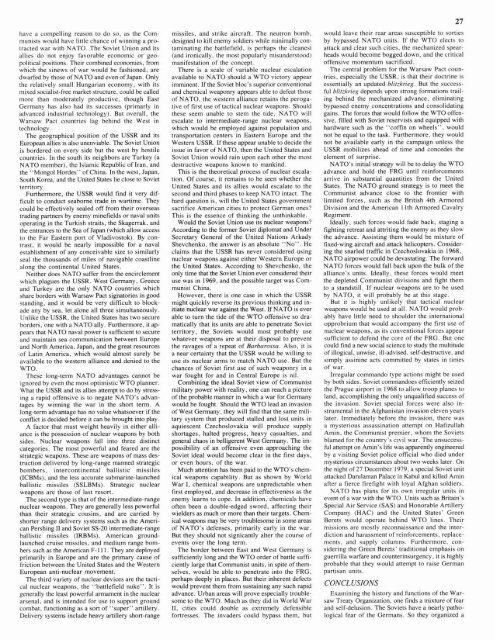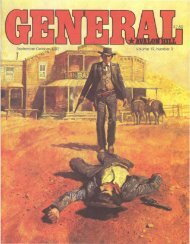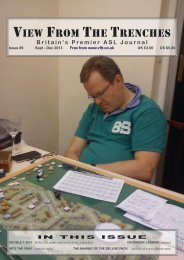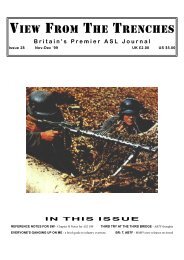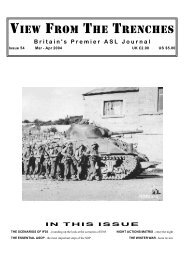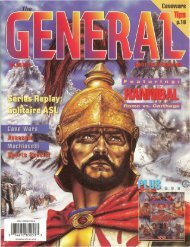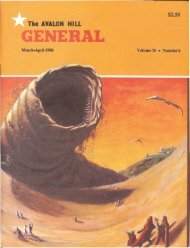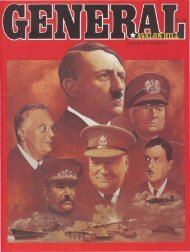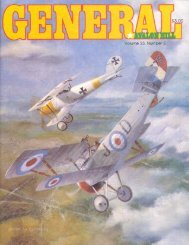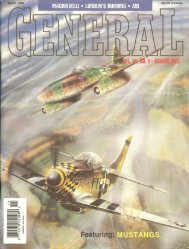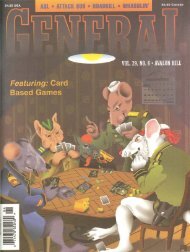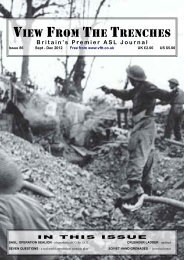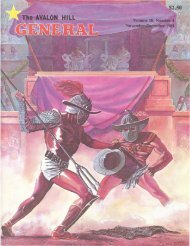You also want an ePaper? Increase the reach of your titles
YUMPU automatically turns print PDFs into web optimized ePapers that Google loves.
have a compelling reason to do so, as the Com-<br />
munists would have little chance of winning a pro-<br />
tracted war with NATO. <strong>The</strong> Soviet Union and its<br />
allies do not enjoy favorable economic or geo-<br />
political positions. <strong>The</strong>ir combined economies, from<br />
which the sinews of war would be fashioned, are<br />
dwarfed by those of NATO and even of Japan. Only<br />
the relatively small Hungarian economy, with its<br />
mixed socialist-free market structure, could be called<br />
more than moderately productive, though East<br />
Germany has also had its successes (primarly in<br />
advanced industrial technology). But overall, the<br />
Warsaw Pact countries lag behind the West in<br />
technology.<br />
<strong>The</strong> geographical position of the USSR and its<br />
European allies is also unenviable. <strong>The</strong> Soviet Union<br />
is bordered on every side but the west by hostile<br />
countries. In the south its neighbors are Turkey (a<br />
NATO member), the Islamic Republic of Iran, and<br />
the "Mongol Hordes" of China. In the west, Japan,<br />
South Korea, and the United States lie close to Soviet<br />
territory.<br />
Furthermore, the USSR would find it very dif-<br />
ficult to conduct seaborne trade in wartime. <strong>The</strong>y<br />
could be effectively sealed off from their overseas<br />
trading partners by enemy minefields or naval units<br />
operating in the Turkish straits, the Skagerrak, and<br />
the entrances to the Sea of Japan (which allow access<br />
to the Far Eastern port of Vladivostok). By con-<br />
trast, it would be nearly impossible for a naval<br />
establishment of any conceivable size to similarly<br />
seal the thousands of miles of navigable coastline<br />
along the continental United States.<br />
Neither does NATO suffer from the encirclement<br />
which plagues the USSR. West Germany, Greece<br />
and Turkey are the only NATO countries which<br />
share borders with Warsaw Pact signatories in good<br />
standing, and it would be very difficult to block-<br />
ade any by sea, let alone all three simultaneously.<br />
Unlike the USSR, the United States has two secure<br />
borders, one with a NATO ally. Furthermore, it ap-<br />
pears that NATO naval power is sufficient to secure<br />
and maintain sea communication between Europe<br />
and <strong>No</strong>rth America, Japan, and the great resources<br />
of Latin America, which would almost surely be<br />
available to the western alliance and denied to the<br />
WTO.<br />
<strong>The</strong>se long-term NATO advantages cannot be<br />
ignored by even the most optimistic WTO planner.<br />
What the USSR and its allies attempt to do by stress-<br />
ing a rapid offensive is to negate NATO's advan-<br />
tages by winning the war in the short term. A<br />
long-term advantage has no value whatsoever if the<br />
conflict is decided before it can be brought into play.<br />
A factor that must weight heavily in either alli-<br />
ance is the possession of nuclear weapons by both<br />
sides. Nuclear weapons fall into three distinct<br />
categories. <strong>The</strong> most powerful and feared are the<br />
strategic weapons. <strong>The</strong>se are weapons of mass des-<br />
truction delivered by long-range manned strategic<br />
bombers, intercontinental ballistic missiles<br />
(ICBMs), and the less accurate submarine-launched<br />
ballistic missiles (SSLBMs). Strategic nuclear<br />
weapons are those of last resort.<br />
<strong>The</strong> second type is that of the intermediate-range<br />
nuclear weapons. <strong>The</strong>y are generally less powerful<br />
than their strategic cousins, and are carried by<br />
shorter range delivery systems such as the Ameri-<br />
can Pershing I1 and Soviet SS-20 intermediate-range<br />
ballistic missiles (IRBMs), American ground-<br />
launched cruise missiles, and medium range bom-<br />
bers such as the American F-1 1 1. <strong>The</strong>y are deployed<br />
primarily in Europe and are the primary cause of<br />
friction between the United States and the Western<br />
European anti-nuclear movement.<br />
<strong>The</strong> third variety of nuclear devices are the tacti-<br />
cal nuclear weapons, the "battlefield nuke". It is<br />
generally the least powerful armament in the nuclear<br />
arsenal, and is intended for use to support ground<br />
combat, functioning as a sort of "super" artillery.<br />
Delivery systems include heavy artillery short-range<br />
missiles, and strike aircraft. <strong>The</strong> neutron bomb,<br />
designed to kill enemy soldiers while minimally con-<br />
taminating the battlefield, is perhaps the cleanest<br />
(and ironically, the most popularly misunderstood)<br />
manifestation of the concept.<br />
<strong>The</strong>re is a scale of variable nuclear escalation<br />
available to NATO should a WTO victory appear<br />
imminent. If the Soviet bloc's superior conventional<br />
and chemical weaponry appears able to defeat those<br />
of NATO, the western alliance retains the peroga-<br />
tive of first use of tactical nuclear weapons. Should<br />
these seem unable to stem the tide, NATO will<br />
escalate to intermediate-range nuclear weapons,<br />
which would be employed against population and<br />
transportation centers in Eastern Europe and the<br />
Western USSR. If these appear unable to decide the<br />
issue in favor of NATO, then the United States and<br />
Soviet Union would rain upon each other the most<br />
destructive weapons known to mankind.<br />
This is the theoretical process of nuclear escala-<br />
tion. Of course, it remains to be seen whether the<br />
United States and its allies would escalate to the<br />
second and third phases to keep NATO intact. <strong>The</strong><br />
hard question is, will the United States government<br />
sacrifice American cities to protect German ones?<br />
This is the essence of thinking the unthinkable.<br />
Would the Soviet Union use its nuclear weapons?<br />
According to the former Soviet diplomat and Under<br />
Secretary <strong>General</strong> of the United Nations Arkady<br />
Shevchenko, the answer is an absolute "<strong>No</strong>". He<br />
claims that the USSR has never considered using<br />
nuclear weapons against either Western Europe or<br />
the United States. According to Shevchenko, the<br />
only time that the Soviet Union ever considered their<br />
use was in 1969, and the possible target was Com-<br />
munist China.<br />
However, there is one case in which the USSR<br />
might quickly reverse its previous thinking and in-<br />
itiate nuclear war against the West. If NATO is ever<br />
able to turn the tide of the WTO offensive so dra-<br />
matically that its units are able to penetrate Soviet<br />
territory, the Soviets would most probably use<br />
whatever weapons are at their disposal to prevent<br />
the ravages of a repeat of Barbarossa. Also, it is<br />
a near certainty that the USSR would be willing to<br />
use its nuclear arms to match NATO use. But the<br />
chances of Soviet first use of such weaponry in a<br />
war fought for and in Central Europe is nil.<br />
Combining the ideal Soviet view of Communist<br />
military power with reality, one can reach a picture<br />
of the probable manner in which a war for Germany<br />
would be fought. Should the WTO lead an invasion<br />
of West Germany, they will find that the same mili-<br />
tary system that produced stalled and lost units in<br />
aquiescent Czechoslovakia will produce supply<br />
shortages, halted progress, heavy casualties, and<br />
general chaos in belligerent West Germany. <strong>The</strong> im-<br />
possibility of an offensive even approaching the<br />
Soviet ideal would become clear in the first days,<br />
or even hours, of the war.<br />
Much attention has been paid to the WTO's chem-<br />
ical weapons capability. But as shown by World<br />
War I, chemical weapons are unpredictable when<br />
first employed, and decrease in effectiveness as the<br />
enemy learns to cope. In addition, chemicals have<br />
often been a double-edged sword, affecting their<br />
wielders as much or more than their targets. Chem-<br />
ical weapons may be very troublesome in some areas<br />
of NATO's defenses, primarily early in the war.<br />
But they should not signicantly alter the course of<br />
events over the long term.<br />
<strong>The</strong> border between East and West Germany is<br />
sufficiently long and the WTO order of battle suffi-<br />
ciently large that Communist units, in spite of them-<br />
selves, would be able to penetrate into the FRG,<br />
perhaps deeply in places. But their inherent defects<br />
would prevent them from sustaining any such rapid<br />
advance. Urban areas will prove especially trouble-<br />
some to the WTO. Much as they did in World War<br />
11, cities could double as extremely defensible<br />
fortresses. <strong>The</strong> invaders could bypass them, but<br />
would leave their rear areas susceptible to sorties<br />
by bypassed NATO units. If the WTO elects to<br />
attack and clear such cities, the mechanized spearheads<br />
would become bogged down, and the critical<br />
offensive momentum sacrificed.<br />
<strong>The</strong> central problem for the Warsaw Pact countries,<br />
especially the USSR, is that their doctrine is<br />
essentially an updated blitzkrieg. But the successful<br />
blitzkrieg depends upon strong formations trailing<br />
behind the mechanized advance, eliminating<br />
bypassed enemy concentrations and consolidating<br />
gains. <strong>The</strong> forces that would follow the WTO offensive,<br />
filled with Soviet reservists and equipped with<br />
hardware such as the "coffin on wheels", would<br />
not be equal to the task. Furthermore, they would<br />
not be available early in the campaign unless the<br />
USSR mobilizes ahead of time and concedes the<br />
element of surprise.<br />
NATO's initial strategy will be to delay the WTO<br />
advance and hold the FRG until reinforcements<br />
arrive in substantial quantities from the United<br />
States. <strong>The</strong> NATO ground strategy is to meet the<br />
Communist advance close to the frontier with<br />
limited forces, such as the British 4th Armored<br />
Division and the American 1 Ith Armored Cavalry<br />
Regiment.<br />
Ideally, such forces would fade back, staging a<br />
fighting retreat and attriting the enemy as they slow<br />
the advance. Assisting them would be mixture of<br />
fixed-wing aircraft and attack helicopters. Considering<br />
the snarled traffic in Czechoslovakia in 1968,<br />
NATO airpower could be devastating. <strong>The</strong> forward<br />
NATO forces would fall back upon the bulk of the<br />
alliance's units. Ideally, these forces would meet<br />
the depleted Communist divisions and fight them<br />
to a standstill. If nuclear weapons are to be used<br />
by NATO, it will probably be at this stage.<br />
But it is highly unlikely that tactical nuclear<br />
weapons would be used at all. NATO would probably<br />
have little need to shoulder the international<br />
opprobrium that would accompany the first use of<br />
nuclear weapons, as its conventional forces appear<br />
sufficient to defend the core of the FRG. But one<br />
could find a new social science to study the multitude<br />
of illogical, unwise, ill-advised, self-destructive, and<br />
simply assinine acts committed by states in times<br />
of war.<br />
Irregular commando type actions might be used<br />
by both sides. Soviet commandoes efficiently seized<br />
the Prague airport in 1968 to allow troop planes to<br />
land, accomplishing the only unqualified success of<br />
the invasion. Soviet special forces were also instrumental<br />
in the Afghanistan invasion eleven years<br />
later. Immediately before the invasion, there was<br />
a mysterious assassination attempt on Hafizullah<br />
Amin, the Communist premier, whom the Soviets<br />
blamed for the country's civil war. <strong>The</strong> unsuccessful<br />
attempt on Amin's life was apparently engineered<br />
by a visiting Soviet police official who died under<br />
mysterious circumstances about two weeks later. On<br />
the night of 27 December 1979, a special Soviet unit<br />
attacked Darulaman Palace in Kabul and killed Amin<br />
after a fierce firefight with loyal Afghan soldiers.<br />
NATO has plans for its own irregular units in<br />
event of a war with the WTO. Units such as Britain's<br />
Special Air Service (SAS) and Honorable Artillery<br />
Company (HAC) and the United States' Green<br />
Berets would operate behind WTO lines. <strong>The</strong>ir<br />
missions are mostly reconnaissance and the interdiction<br />
and harassment of reinforcements, replacements,<br />
and supply columns. Furthermore, considering<br />
the Green Berets' traditional emphasis on<br />
guerrilla warfare and counterinsurgency, it is highly<br />
probable that they would attempt to raise German<br />
partisan units.<br />
CONCLUSIONS<br />
Examining the history and functions of the Warsaw<br />
Treaty Organization, one finds a mixture of fear<br />
and self-delusion. <strong>The</strong> Soviets have a nearly pathological<br />
fear of the Germans. So they organized a


